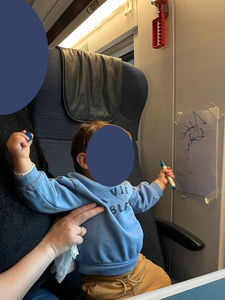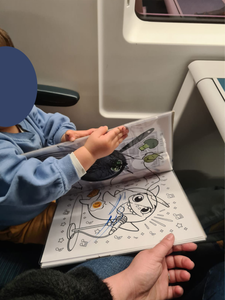2025-M7-Group 7
Co-design
To ensure that the end product meets the specific needs of our case owner multiple co-design methods where used:
Introduction interview
Journey mapping
Creating a list of requirements
Ideating together
Testing a low fidelity prototype
The insight are presented below.
Introduction interview insights
The participant is a young mother working full-time at the University of Twente. Her husband works in the UK and travels frequently. Their 1.5-year-old son, is active and enjoys dancing and coloring, while screen time is avoided.
She travels monthly by train to France or the UK with her child and struggles with carrying both him and the stroller, especially during peak hours.
Balancing work, motherhood, and social life is important to her, though she has less time for personal activities like rowing or going to the cinema.
From the interview, key challenges were identified: ease of travel, personal time, teaching French, and keeping him occupied. Travel difficulties were the most pressing, leading to the focus on designing a solution for this issue.
Introduction interview
Goal
Understand her daily life, challenges, and needs to guide the design process. Ideally conducted in person, the interview was held online due to the user’s location abroad.
The first meeting with the user, our co-designer, was structured as an interview to efficiently gather insights within a 45-minute timeframe.
Before the interview, the case of the project —"Mother and Child"—was shared, providing a general direction. However, as this was still broad, initial questions centered on the interaction between mother and child. As the interview progressed, more precise questions were asked to gain a deeper understanding of her situation and refine the design focus.
Interview setup
The interview was conducted via Teams, with the participant on one side and five group members on the other.
To ensure an effective session, roles were divided: one member led the conversation, another took visual notes, and a third created a mind map. The remaining two focused on note-taking, research, and asking follow-up questions to support the discussion.
Next to this, a guideline was set up to ensure a successful interview. The guidelines were as follows:
- Let the Interviewee talk on her own initiative
- Make notes together with the interviewee
- Keep asking why?

Journey mapping insights
The child does not sleep during the train journey and needs to be kept occupied. Since he does not have his own seat, he sits on the table in front of the SU, meaning space constraints must be considered. Boarding, transfers, and bathroom breaks are not problematic. However, the main challenge is keeping him engaged for the entire ride so the SU can rest preferably. Additionally, it could be looked into walking to the train easier, rather than carrying him in her arms.
Journey mapping
Goal
Get in depth insights into the travel experience by train.
During the second meeting, a premade journey map was reviewed and discussed to identify key considerations.
1. Preparing to leave home
-
SU carries a backpack and a small suitcase.
-
Occasionally, a stroller is used, but preferably not.
2. Walking to the train station
-
The station is a 15-minute walk.
-
SU carries him in her arms or, if a stroller is used, he sits in the stroller.
3. Checking in & navigating the station
-
SU arrives with enough time, ensuring a stress-free check-in and navigation.
4. Boarding the train
-
If using a stroller, people often help lift it onto the train.
-
Without a stroller, he can walk, but his pace is slow, and he may not follow the correct direction.
5. Passing time on the train
-
SU brings activities like colouring books, stickers, and drawing materials, rotating them throughout the trip.
-
Occasionally, she takes short walks through the train for a break.
-
He does not sleep on the train, so he needs continuous entertainment. If bored, he may cry out of frustration.
6. Bathroom breaks
-
Diaper changes are possible either on the train or at the station.
7. Transfers
-
Transfers provide a welcome break between travel segments.
8. Final leg to the destination
-
In the UK, a metro or tram is taken to the final destination.
-
In France, SU is picked up directly from the station.

List of requirements insights
Priority is given to safety and portability, with a focus on size and longevity—ensuring it remains engaging from now until the child is three years old. It is preferable to have three well-developed games rather than multiple incomplete ones. Less important factors include waterproofing, aesthetics, and language learning.
List of requirements
Goal
Get insight in the priorities of the SU.
Before this session, the team brainstormed a comprehensive list of requirements. During the session, the co-designer was encouraged to contribute her own requirements and rank the predefined ones using the Must, Should, Could, and Will Not scale.

List | Requirement | Explanation |
|---|---|---|
1. Functional requirements | ||
1.1 | The play kit shall be suitable for kids between 1 and 3 years old. | The age range selected by the case owner and keeping in mind the development of the toddler |
1.2 | The play kit shall be portable
| Portability is needed for comfortable travelling in the train |
1.3 | The play kit should consist of multiple games | From the research conducted, the attention span of a toddler of 1.5 year old was found to be at 4-6 seconds
|
1.4 | The play kit shall incorporate requirements from the case owner into the design | Ensure the mothers needs are met for the final product |
1.5 | The design shall be able to withstand the interactive forces from the toddler | Prevent the play kit to be damaged while being used |
1.6 | The design should be able to withstand a drop from 1.5 meter | The average height of seats in trains along with an additional safety factor |
1.7 | The play kit should be water resistant | In the case of bad weather or unexpected spills |
1.8 | The play kit should develop the toddlers knowledges in the required languages | Requirement from the parent case owner |
1.9 | The play kit shall not have any swallowable parts by a 1.5 year old | Prevent danger for toddler |
Ideation insights
Gain insight into the child's interests, such as dancing, drawing, stickers, interactive books, pretend cooking/cleaning, and screwing/unscrewing objects. A great feature would be the ability to attach the prototype to the window, creating a sense of a new dimension. Additionally, each side of the prototype should feel like a completely different game for added variety and engagement.
Ideation
Goal
Directly adapt concepts to SU liking and come up with new ideas together.
During the third meeting three concepts where brought to the table which where assesed and adapted.
Three concepts
The idea of the interactive book was preferred by the case-owner for multiple reasons.
Firstly, the size of the book would make it convenient to carry in her backpack together with, or in the place of, her laptop. For the final product, the size of a laptop was chosen to uphold this advantage.
Secondly, having multiple games is preferred to entertain her child for longer. Where the idea of turning the page giving the feeling of a completely different game might make her child interested for longer than if the games were to be on the sides of a cube.
Lastly, the games in the book would fit best with what activities her son likes at this moment.
Low fidelity prototype insights
Improvements
-
Stickers where hard to grab.
-
Holder for the pens/tape to store.
-
Marker was hard to erase, would be nice to have a build-in eraser.
-
Would be nice to have border around the pages so he does draw outside of it.
-
Some stickers where too small.
-
Possibility to have one page open at the time.
Strengths
-
Game which included cooking, landscape, and stickers.
-
Format was practical to carry.
Low fidelity
Goal
Get to know what works and what needs to be changed for the final prototype.
A low fidelity prototype was made to test out by the SU during a train ride. It included colouring pages, stickers, different games, and a whiteboard. Feedback was received after it.









